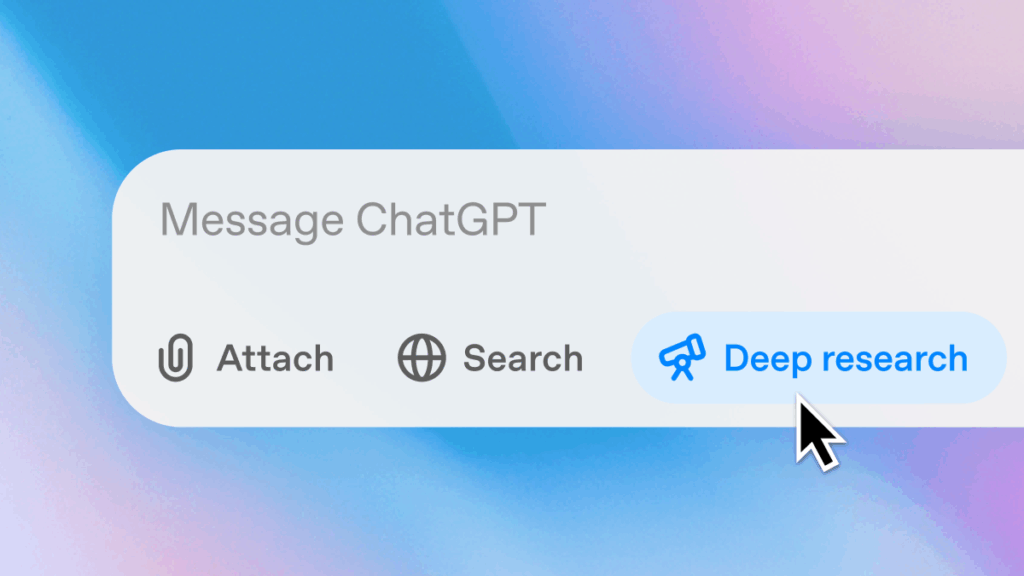
<span class=caption-credit> OpenAI</span>
OpenAI Deep Research Tool Now Available for Free ChatGPT Accounts
The OpenAI Deep Research Tool is finally becoming accessible to free ChatGPT users, marking a significant expansion of advanced AI research capabilities to non-paying customers. This powerful feature, previously exclusive to paying subscribers, can now be utilized by anyone with a ChatGPT account, albeit with monthly usage limitations. The expansion introduces a lightweight version powered by OpenAI’s new o4-mini model, designed to deliver comparable quality at greater efficiency.
Table of Contents
- OpenAI Deep Research Tool: Democratizing Advanced AI Research
- The New o4-mini Model: Performance and Efficiency
- Understanding Usage Limits Across Different Subscription Tiers
- Key Capabilities of the Deep Research Tool
- What Free Users Can Expect from the Deep Research Tool
- Future Implications for AI Research Accessibility
The OpenAI Deep Research Tool allows users to generate comprehensive reports with citations from multiple online sources. Image: OpenAI
OpenAI Deep Research Tool: Democratizing Advanced AI Research
In a significant move toward democratizing advanced AI capabilities, OpenAI’s Deep Research Tool is now becoming available to users with free ChatGPT accounts. This announcement, made on April 24, 2025, represents a major shift in OpenAI’s approach to feature accessibility, bringing powerful research capabilities to a much wider audience.
The Deep Research Tool has established itself as one of ChatGPT’s most valuable features for users requiring in-depth information gathering. It can analyze hundreds of online sources simultaneously, creating comprehensive reports that include proper citations – a significant improvement over ChatGPT’s standard capabilities that often lack source attribution.
Until now, this powerful feature was restricted to paying customers with Plus, Pro, Team, Enterprise, and Edu subscriptions. Each subscription tier came with specific monthly allowances for using the OpenAI Deep Research Tool, creating a clear division between free and premium experiences.
Key Changes to Deep Research Access
- Free users now get 5 monthly inquiries using the lightweight o4-mini model
- Plus and Team subscribers receive an additional 15 inquiries (total: 25)
- Pro subscribers receive an extra 125 inquiries (total: 250)
- Enterprise and Edu users will get 15 additional inquiries starting next week
- Automatic switching to the lightweight model when original query limits are reached
The New o4-mini Model: Performance and Efficiency
The expansion of the OpenAI Deep Research Tool is made possible through the introduction of a new lightweight version powered by the o4-mini model. According to OpenAI, this model delivers slightly shorter responses compared to the original version but maintains comparable intelligence and quality while being “significantly cheaper to serve.”
In their announcement, OpenAI specified that the o4-mini-powered version of the Deep Research feature is “nearly as smart as the deep research people already know and love,” suggesting minimal compromise on performance despite the efficiency improvements.
This balance of performance and efficiency is crucial for OpenAI’s strategy of expanding access without overwhelming their systems or dramatically increasing operational costs. The o4-mini model represents an important technical achievement that makes broader access to the Deep Research Tool economically viable.
Comparative visualization of the original Deep Research Tool and the new lightweight version powered by o4-mini.
Understanding Usage Limits Across Different Subscription Tiers
With the expansion of the OpenAI Deep Research Tool, the company has established a multi-tiered system of access limits based on subscription level. These limits reflect the balance OpenAI is trying to strike between wider accessibility and sustainable service delivery.
Prior to this update, Plus subscribers were limited to just 10 Deep Research inquiries per month, while Pro subscribers paying $200 monthly could utilize the feature up to 125 times. The new system significantly expands these allowances while introducing access for free users:
| Subscription Level | Original Model Limit | o4-mini Model Limit | Total Monthly Inquiries |
|---|---|---|---|
| Free | 0 | 5 | 5 |
| Plus/Team | 10 | 15 | 25 |
| Pro | 125 | 125 | 250 |
| Enterprise/Edu | Varies | +15 (starting next week) | Varies |
This graduated approach maintains the value proposition for paying subscribers while giving free users meaningful access to the OpenAI Deep Research Tool. When users reach their limit on the original version, ChatGPT automatically switches to the lightweight version powered by o4-mini.
Key Capabilities of the Deep Research Tool
The OpenAI Deep Research Tool represents a significant advancement in AI-assisted research capabilities. Its core functionality allows it to analyze numerous websites and sources simultaneously, synthesizing information into coherent reports that include proper citations – a critical feature for academic, business, and journalistic applications.
According to OpenAI, the tool is “fine-tuned on the OpenAI o3 reasoning model,” giving it enhanced analytical capabilities compared to standard ChatGPT responses. This specialized training enables the Deep Research Tool to:
- Evaluate the credibility of sources
- Synthesize information from diverse perspectives
- Provide organized reports with proper citations
- Compare conflicting information across sources
- Identify knowledge gaps and research limitations
These capabilities make the tool particularly valuable for users needing comprehensive information on complex topics, whether for academic research, business intelligence, or personal learning. With its citation features, the OpenAI Deep Research Tool also helps address one of the persistent criticisms of generative AI – the lack of transparency about information sources.
Effective Uses for the OpenAI Deep Research Tool
- Academic literature reviews with proper citations
- Market research across multiple industry sources
- Fact-checking information from diverse perspectives
- Gathering comprehensive information on complex topics
- Creating educational resources with verified sources
What Free Users Can Expect from the Deep Research Tool
For the first time, users with free ChatGPT accounts can access the OpenAI Deep Research Tool, albeit with more significant limitations than paying subscribers. Free users will have access to up to five monthly inquiries using the lightweight o4-mini version of the tool.
While five inquiries may seem modest, it represents a meaningful introduction to the Deep Research capabilities for casual users or those evaluating whether to upgrade to a paid subscription. Each inquiry still delivers the core value proposition: comprehensive information gathering across multiple sources with proper citations.
The o4-mini model powering these free inquiries produces slightly shorter responses than the original version but maintains comparable intelligence and quality. Free users can expect responses that are comprehensive and well-cited, if somewhat more concise than those generated by the original model available to paying subscribers.
This limited but meaningful access to the OpenAI Deep Research Tool allows free users to experience one of ChatGPT’s most powerful capabilities without financial commitment, potentially driving greater awareness and adoption of the platform’s premium features.
Maximizing Limited Deep Research Access
For free users with only 5 monthly inquiries, consider these strategies:
- Formulate questions carefully before using your limited queries
- Focus on complex topics that benefit most from multi-source research
- Save the outputs of your Deep Research queries for future reference
- Use standard ChatGPT for simpler questions to preserve Deep Research queries
- Experiment with different query formulations to understand what produces the best results
Future Implications for AI Research Accessibility
The expansion of the OpenAI Deep Research Tool to free accounts signals an important shift in how advanced AI capabilities are being democratized. This move aligns with broader industry trends toward making powerful AI tools more accessible while maintaining sustainable business models.
By introducing the o4-mini model that delivers comparable results at lower computational cost, OpenAI demonstrates a technical approach to expanding access without proportionally increasing infrastructure demands. This model could set a precedent for how other advanced features might be adapted for broader accessibility in the future.
The tiered access system also reveals OpenAI’s strategy for balancing accessibility with premium value. Free users get meaningful but limited access, while paying subscribers receive substantially more generous allowances that scale with subscription level.
As AI research tools become more accessible, we can anticipate wider adoption across educational, professional, and personal contexts. The OpenAI Deep Research Tool‘s ability to provide cited sources addresses one of the key limitations of generative AI, potentially expanding its acceptance in academic and professional environments where source verification is essential.
The OpenAI Deep Research Tool at a Glance
- Previously exclusive to paying subscribers, now available to all ChatGPT users
- Powered by either the original model or the new lightweight o4-mini model
- Analyzes multiple websites and sources to create comprehensive reports
- Includes proper citations for all information sources
- Access limits vary by subscription tier, with free users getting 5 monthly inquiries
- Automatic switching to lightweight model when original model limits are reached
- Enterprise and Edu users getting expanded access starting next week
The expansion of the OpenAI Deep Research Tool to free users marks an important milestone in AI accessibility. By balancing advanced capabilities with sustainable access models, OpenAI is making powerful research tools available to a much broader audience while preserving incentives for premium subscriptions. This approach could serve as a template for future AI feature democratization across the industry.





